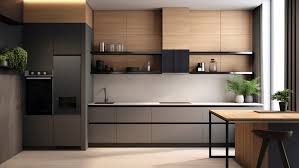Cabinets are a crucial component of any home, serving not only as a functional storage solution but also as a significant element of interior design. Whether you’re remodeling your kitchen, updating your bathroom, or designing a custom-built wardrobe, selecting the right wood for your cabinets is a decision that will impact the aesthetics, durability, and functionality of your space. This guide explores various cabinet wood types, providing insights into their unique characteristics and suitability for diverse design styles.
Alder is a popular choice for those seeking a warm and inviting look. Known for its soft nature, alder is relatively easy to work with and takes stains well, making it versatile for a range of finishes. With a fine grain and uniform texture, it is ideal for rustic or farmhouse-style designs. However, its softness also means it is more prone to dents and scratches, so it may not be the best option for high-traffic areas.
Birch offers a more economical choice without sacrificing quality or style. It has a subtle grain pattern that can mimic the appearance of more expensive woods like maple when properly stained. Its strength and stability make it suitable for cabinets that will endure daily wear and tear. Birch is a fantastic option for contemporary and minimalist designs, as it can be finished to fit a clean, streamlined look.
Cherry is renowned for its rich, elegant appearance and deep color that darkens beautifully over time. The wood’s smooth grain and warm hues make it a favorite for traditional and classical cabinet designs. Cherry is more expensive than some other options, but its durability and the luxurious aesthetic it brings can justify the investment. Its photosensitivity means it will darken with exposure to sunlight, adding character as it ages.
Hickory stands out for its dramatic color variations and attractive grain patterns. It’s one of the hardest and most durable woods used for cabinetry, making it well-suited for busy households. The distinct look of hickory can bring a touch of rustic charm or an adventurous vibe to space, perfect for those looking to make a bold statement with their cabinetry. Its robustness also ensures longevity, even in high-use areas like kitchens.
Maple is a favorite for those who desire a sleek, modern appearance. It is a strong, dense wood that resists wear and tear, making it ideal for cabinets that will see a lot of use. With a smooth, even grain, maple can be stained uniformly or left natural for a lighter, contemporary appearance. It’s a versatile option that pairs well with various design styles, from ultra-modern to traditional.
Oak, especially red oak, is synonymous with durability and timelessness. It has a prominent grain pattern, lending a bold texture that can be a statement in itself. Oak cabinets are a staple in traditional and country-style homes thanks to their resilience and classic look. They can be easily stained in various shades to match different color schemes, offering flexibility alongside strength.
Walnut is the choice for those who favor luxury and sophistication. Its rich, deep brown tones and striking grain patterns can elevate any room. Walnut is a premium wood, commanding a higher price point, but its distinct elegance makes it worth considering. The wood is relatively hard and durable, ensuring that your cabinets stand the test of time while maintaining their exquisite appearance.
In conclusion, choosing the right wood for your cabinets depends on a combination of personal taste, budget, and the functional requirements of the space. Each wood type offers unique attributes that can enhance the beauty and utility of your cabinetry. Whether you opt for the warmth of alder, the elegance of cherry, the robustness of hickory, or the luxury of walnut, understanding the characteristics of each wood will help you make an informed decision that suits your design vision and lifestyle needs. By exploring these cabinet wood types, you can create cabinets

